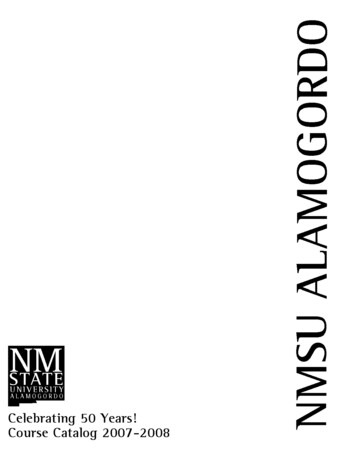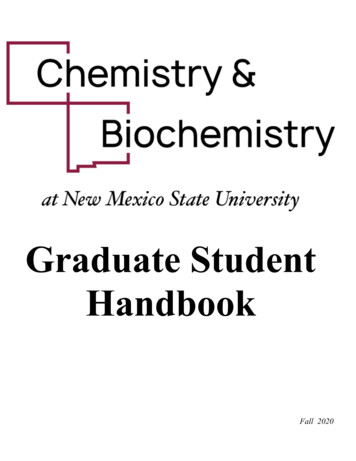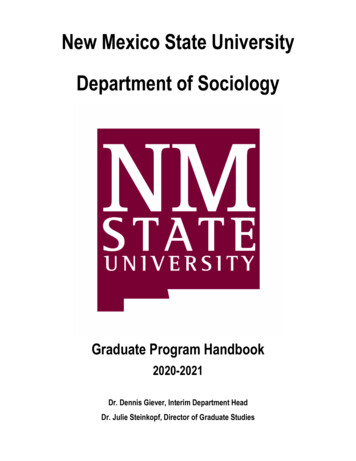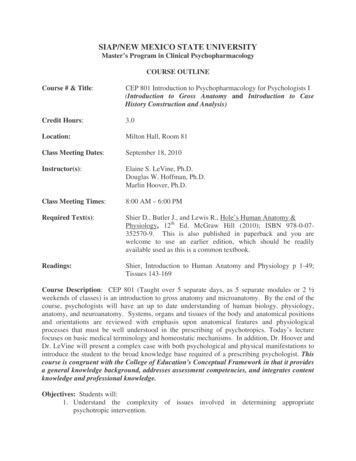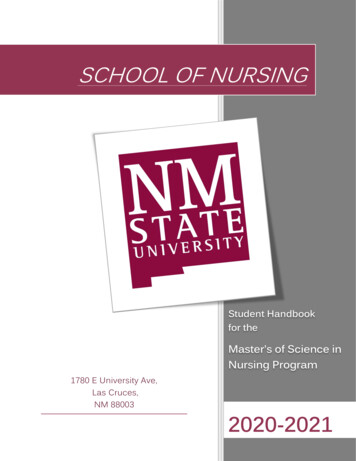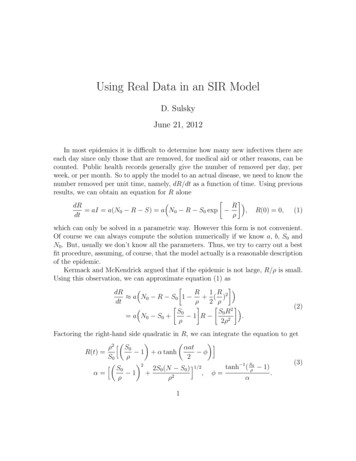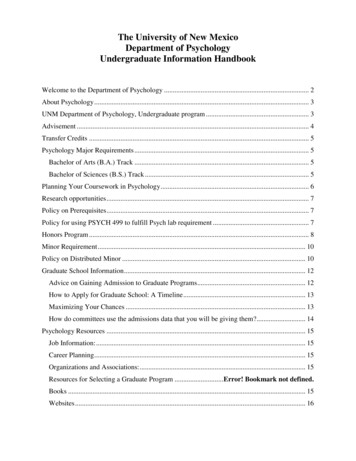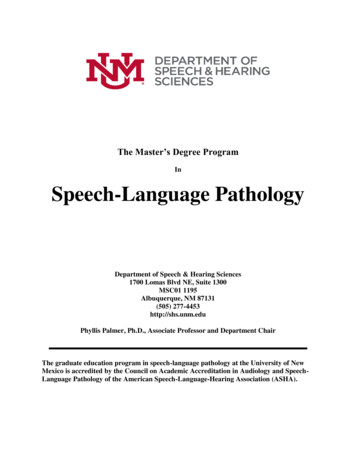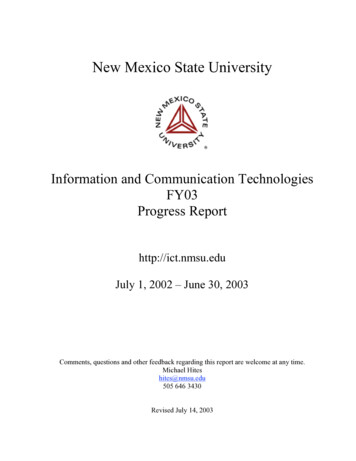
Transcription
New Mexico State UniversityInformation and Communication TechnologiesFY03Progress Reporthttp://ict.nmsu.eduJuly 1, 2002 – June 30, 2003Comments, questions and other feedback regarding this report are welcome at any time.Michael Hiteshites@nmsu.edu505 646 3430Revised July 14, 2003
SummaryInformation technology services at New Mexico State University are provided through acombination of the centralized, campus-level, college-level and departmental staff. Thisprogress report focuses on the primary central IT group: Information and CommunicationTechnologies (ICT). Although the progress report is concentrated on ICT, the goals presentedin this document reflect strong collaboration between ICT, other IT groups throughout NMSUand the NMSU user community.ICT’s mission is to create an environment where the university community can useinformation technology efficiently and effectively to support NMSU’s strategic direction as aleading teaching and research university. ICT consists for 119 staff members in working inadministrative and academic applications, telecommunication and networking, at-the-desktopsupport for faculty and staff, help desk services, Windows, Unix and mainframe serversupport, administrative production control, student computing laboratories, electronic coursemanagement, web services, technology-enabled classrooms, email, directory services andinformation security.During FY03 in the area of telecommunications and networking, both wired and wirelessnetworking was enhanced, several campus buildings were re-wired, Internet bandwidth wasincreased, bandwidth for peer-to-peer file sharing applications was limited, the root networkwas diversified and Caller ID was added to the voice network. NMSU received 700,000through the New Mexico Commission on Higher Education (CHE) process to improvedistanced education infrastructure and to upgrade NMSU’s core network facilities.Additionally, ICT continued its collaboration with the research community and received 110,000 in funding through the National Science Foundation (NSF) Experimental Programto Stimulate Competitive Research (EPSCoR) grant process to improve research connectivityto the four-year higher education institutions in the state.Demands for specific instructional technology by faculty and students led to improvingservices for web-based course management, computer laboratories and collaboration tools.Several new electronically enhanced classrooms were installed in FY03 and the WebCTcourse management server was upgraded to accommodate the increased interest in distancelearning and technology rich education. The Centra web-based audio collaboration tool wasused extensively to connect students, instructors and researchers from throughout the world.Training was provided by ICT for each of the tools.ICT’s Computer Systems division focused on disaster recovery, cost reduction for servers andapplications, and enhancement to email. A new mainframe was purchased to host the existingadministrative applications on a more powerful computer and save on maintenance. Theformat of email storage was changed to improve email performance and a SPAM filter wasinstalled to help staff and faculty manage their email. In the area of PC service andmaintenance, several new annual maintenance contracts were initiated so that the central ICTstaff can service departmental personal computers in a cost-effective manner. The remote sitebackup facility at NMSU was upgraded, and offsite backup is now provided on a daily basis.Finally, disaster recovery procedures were written for the primary systems and services.2
Most of the effort in administrative applications at NMSU was in system maintenance, systemconversion and web-enabling services. The new web-based student employment system helpsstudents find jobs and move through the hiring process with greater effectiveness. Printingpaychecks with new laser printers improved efficiency and increased security, and the webbased parking system allows visitors to obtain daily permits without visiting the parkingoffice. The admission system was migrated to the most recent release, and the conversion ofthe legacy administrative systems to a modern DB2 database was ongoing throughout FY03.ICT completed the first phase of the “Business Recovery / Disaster Recovery Plan”. The planidentifies and prioritizes all the “critical” computer systems and infrastructure which affectthe health, safety, communications and processing capabilities of the university. Eachfunctional area which would be impacted in the event of a disaster participated and created“system impact” statements, identified “critical time frames” as well as alternative methods ofconducting business until systems or infrastructure is restored. The response teamorganization was created and restoration procedures were listed. Phase 2 of the plan, willaddress departmental areas of main campus as well as the branch campuses.During FY03, the primary committee structure for information technology was established.There are many other information technology committees throughout NMSU, however theforemost advisory groups for ICT and the Chief Information Officer are described in thefollowing table.CommitteeICT Advisory CommitteeSIS CommitteeAdministrative Matters CommitteeFaculty Senate TechnologyCommitteeStudent Technology AdvisoryCommitteeRoleExecutive oversightStudent information systems andservicesFinancial and human resourcessystems and servicesFaculty technology issuesStudent technology issuesExample responsibilitiesERP final decisionPolicy, planning and enhancementprioritiesFRS and HRS system replacementTechnology-enabled classrooms,web-based instructionStudent computer labs, portalThe ICT FY03 Progress Report depicts all of the FY04 action items, however many of themcan be generalized into larger goals, namely: Condense and unify backend systems and databases for administrative information tosupport a strong foundation for web-based access and self service.Promote collaboration to support university data and information technologies tosatisfy the needs of NMSU’s centralized/decentralized administrative and academicstructure.Discuss appropriate cost recovery strategies for information technology servicesincluding internal and external sources.Provide enhanced live training, help desk services and web-based self-support ininformation technology for students, faculty and staff.3
Provide increased support for faculty researchers, especially those using highperformance computing.Develop and implement of high-bandwidth connectivity for NMSU and for NewMexico higher education in general.4
Table of Contents1.ICT Mission and Organizational Structure62.Administrative Computing Systems and Services83.Computing Operations, Maintenance and Production Control124.Telecommunication and Networking Services185.Instructional Technology Services306.ICT FY 2004 Objectives and Projects355
1.ICT Mission and Organizational StructureICT’s mission is to create an environment where the university community is able to useinformation technology efficiently and effectively to support its mission as a leading teachingand research university. ICT provides computing and communication infrastructure: thevoice, video, and data systems that provide access to the information facilities of theuniversity and to the information resources of the world. ICT maintains the systems andapplications that support the daily operation of the university for administration, research andinstruction. The rapid pace of technological change places increasing demands for electronicaccess to information and integration of technology throughout the university's programs andactivities.ICT aspires to support: Access to high-quality electronic systems, networks, and technical support staff,sufficient to meet the needs of students, faculty, and staff throughout the university. Learning, research, and creative efforts of students and faculty in all disciplines. Integration of the most current information technology into instructional programs toprepare students to compete in a rapidly changing world. The critical information resources and services of the university. Services that meet student needs and improve student satisfaction and performanceFunctionally, ICT is comprised of four divisions: University Systems, Computer Systems,Telecommunication and Networking and Instructional Support Services. The role of eachdivision is summarized briefly in the following section.ICT University SystemsEighteen staff members, 1.1M annual budget.DepartmentStudent Information ServicesFinancial Information ServicesSpecial ProjectsRegular staff767Student staff000University Systems provides technical and programming support for the design, deployment,and maintenance of institutional systems associated with business and finance, humanresources, student information and financial aid, as well as several departmental systems.University Systems consults and evaluates systems and services to support the business needsof NMSU’s staff, faculty and students through administrative applications.ICT Computer SystemsForty-three staff members, 3.8M annual budget.DepartmentUniversity Computer CenterMainframe Systems AdministrationPC Server AdministrationUnix Systems Administration6Regular staff16665Student staff5063
DepartmentPC Support ServicesDatabase AdministrationRegular staff53Student staff11Computer Systems is responsible for the operation of the core IT services of NMSU includingthe operation of the data center, email, IT security, database administration, along withadministration of servers and desktop computers with various operating systems.ICT Computer Systems manages the NMSU data center. UCC is responsible for the regularoperations of central computers and university processing of data. UCC is the focal point ofNMSU’s administrative computing.ICT Telecommunication and Networking ServicesThirty-five staff members, 4.4M annual budget.DepartmentBusiness ServicesVoice and Alarm ServicesData and Video ServicesRegular staff12812Student staff747Telecommunication and Networking Services (TNS) has two main functions: design andmaintain the fundamental telecommunication infrastructure and manage the one-stopCustomer Service Center (helpdesk) for ICT. The infrastructure includes but is not limited tothe information to Campus Police, Alarm Services (Fire and Security), Networking Services(Internet, Local Area, Wide Area, Wired and Wireless), Video Conferencing Infrastructure,and Voice Services (Wired and Wireless).ICT Instructional Support ServicesTwelve staff members, 1.3M annual budget.DepartmentWeb ServicesUniversity Computer LaboratoriesScholarly TechnologyRegular staff235Student staff3601Instructional Support Services consists of 11.5 full time staff, 70 students, and a 1.3 millionannual operating budget. Instructional Support Services is responsible for providing end-userservices to students, faculty and staff primarily related to web-based technologies and specialfocus on the academic mission of the university.Instructional Support Services provides application administration, documentation, training,and support for http://www.nmsu.edu. NMSU’s web-based instructional delivery systems(WebCT and Centra), the general student computing labs, multimedia classroom technology,and campus-wide software licensing programs. Instructional Support Services also developspresentations, brochures, e-newsletters and web sites for many of ICT’s services.7
2.Administrative Computing Systems and ServicesThis section details progress supporting NMSU’s Administrative Computing Systems andServices by ICT University Systems.ICT’s University Systems provides technical and programming support for the design,deployment, and maintenance of institutional systems associated with business and finance,human resources, student information, financial aid as well as several departmental systems.University Systems consults and evaluates systems and services to support the business needsof NMSU’s staff, faculty and students through administrative applications.Software for Research Proposal Tracking (InfoEd)ICT assisted the Office of Vice Provost for Research in the selection of InfoEd Internationalto automate tracking and development of research proposals. The current process is paperbased and manual process which sometime results in delays or confusion when trackingproposals and submitting them to granting agencies. The InfoEd system is web based andautomates and streamlines various processes to support grant writing at NMSU.Upgrade for Electronic Payment Software (CashNet)ICT assisted Business and Finance in evaluating and selecting the upgrade for NMSU’scentral credit card payment processing system. The new version of CashNet will include aweb-based component for secure electronic payment system over the web and allowindividual departments to build “shopping cart” websites.Terminal Services for Windows ApplicationsICT assisted in the implementation of Microsoft Windows Terminal Services to provideaccess to Business and Finance’s new web based procurement card system. TerminalServices allows non-Windows computers, e.g. Macintosh and Sun, to use Microsoft softwaredesigned to run only on Windows operating systems.Degree Audit Report System (DARS, DARwin, and mlStatistics from the Fall 2002 NMSU fact book indicate that NMSU offers 22 doctoral degreeprograms, 50 masters programs and 72 baccalaureate programs. There were 15,243 studentsenrolled during the 2001-2002 academic year and 1897 bachelors degrees, 595 mastersdegrees, and 79 doctoral level degrees were granted. The effort expended by both studentsand staff to monitor and validate of progress toward these degree requirements is significant.To provide an automated solution to gain efficiencies and to ensure consistency in themonitoring of requirements, ICT implemented the CICS COBOL version of Miami of Ohio’sdegree audit system (DARS). Since implementation of DARS, the Dona Ana branch haselectronically compiled requirements for one of its three divisions. The Arts and SciencesCollege has completed 50% (15 out of 30) of their programs and 2,000 audits were generatedfor AS students in Spring 2003.8
Student Employment Services system (SES Ventana)https://aggieapps.nmsu.edu:8088/ses/In the past, students and university and community employers had no access to on-line regularstudent employment activities for the approximately 1500 students on NMSU’s payroll. ICTand the Student Employment Office designed a Java application that provides its audiences(Main and Dona Ana campus students and employers and local community employers) withthe ability to perform all employment activities via the web: posting of jobs, registering as astudent, searching for jobs, applying for jobs or waivers, receiving web and emailnotifications, viewing applicant profiles, and selecting students. The approximately 500community employers of students can now post jobs and perform hiring selections real-time.Hiring information integrates with existing systems and student eligibility is monitored withinthe system.Visitor Parking e-Permits system rs to the university previously had to arrange for temporary parking permits bycontacting the NMSU Police Department. The new e-permit system allows visitors togenerate their own temporary parking permit(s) via the web. The permits can then be printedand displayed on vehicle dashboards when visiting campus. The availability of e-permits hasallowed parents and others quick access to parking permits without having to check-in withthe Police Department when they visit campus.Portal System Demonstration Site ww3.ca.com/Solutions/Solution.asp?ID 303ICT, like other universities, has an active interest in the direction of portal technology as itrelates to higher education. Portals promote the concept of university community based onwhat role(s)/affiliation(s) the user plays and provide a customizable, adaptive desktop for eachuser that may eventually replace the desktop as far as where applications run. ICT installedthe reference implementation of JA-SIG’s uPortal and CA installed a version of theirCleverPath portal at NMSU for a trial period. The two portal products are being evaluated todetermine (a) how well each meets the needs of the various university audiences, (b) ease ofinstallation and maintenance, (c) resources requirements, and (d) total cost of ownership.Vistas DB2 project http://ict.nmsu.edu/ is/us/DB2/index.htmIn an effort to migrate administrative applications to one database platform, Vistas/SAR isbeing converted from utilizing Mantis and the Supra database to CICS/COBOL and DB2.Once Vistas, SAR, HRMS, and SES Ventana are all on DB2, the integration of systems anddata, the ability to utilize end-user friendly ad-hoc reporting tools due to ODBC compliancy,and the savings to be gained by no longer having to pay for the high cost of SUPRA databasemaintenance, provide significant benefits to our clients and to ICT.Student and Exchange Visitor Information System (SEVIS)Assisted with the analysis, requirements definition, setup and interfaces to fsaAtlas in supportof the Student and Exchange Visitor Information System (SEVIS), the new U.S. governmentinternet-based system which electronically monitors and reports on international students,exchange visitors and their families using I-20 (F visa) and DS-2019 (J visa) immigrationdocuments.9
Implementation of Laser Check PrintingAssisted in the selection, procurement, and installation/setup of a third party vendor softwarepackage, Create-A-Check Business Solutions, to initially accommodate the MICR laserprinting of payroll checks/advices. Since then, manual checks and W-2s have beenimplemented as well. With the implementation of Create-A-Check, NMSU has realizedbenefits in the savings of pre-printed checks, a reduction in labor costs, better print quality,the capability to reprint checks quickly and easily, less interruptions and errors in printing,and a peace of mind knowing that the use of blank check stock provides better security and areduction in check fraud.Specific Human Resources System Improvements1.Installed four HRMS maintenance releases to meet regulatory requirements.2.Implemented mandatory New Mexico State University Retirement Board (ERB)reporting and developed polices for the new retiree return-to-work program.3.Implemented Job scheduler for HRMS, resulting in streamlined and automatedprocessing reducing the chance for human error, therefore, reducing the number ofabends in the batch processing.4.Created a separate Employment Authorization Form (EAF) archival database gavethe users the capability of accessing historical data without impacting the responsetime of the EAF production system.5.Performed feasibility analysis for streamlining the Supplemental Compensationapproval process on EAF. Analysis document provides options forimplementation and is currently in its initial stages of review.Specific Financial Systems Improvements1.Enhanced FRS batch processing resulted in same day feeds into FRS providingtimely updates and requiring less human intervention to batch processing updates.2.Assisted with the analysis, design, and requirements definition of the interfacesrequired for the Procurement Card workflow project.3.Utilized the recently purchased McAfee E-Business Server software to transmitthe automatic deposit payroll files to Bank of America using Internet File TransferProtocol (FTP). E-Business Server employs data encryption and authentication toprotect the privacy of FTP transmissions.Specific Personnel System Enhancements1.Enhanced professional and classified employee salary letters and allowed for thedesignation of signatures to be associated with each individual employee’s letter,b
Statistics from the Fall 2002 NMSU fact book indicate that NMSU offers 22 doctoral degree programs, 50 masters programs and 72 baccalaureate programs. There were 15,243 students enrolled during the 2001-2002 academic year


